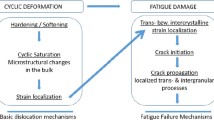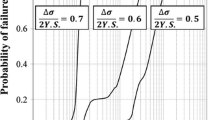Abstract
Metallic thin foils are essential structural parts in microsystems,which may be subjected to fatigue loading caused by thermal fluctuations and mechanical vibrations influencing their reliability in numerous engineering applications. It is well known that the fatigue properties of bulk material cannot be adopted for small scaled structures. For a better understanding of the `size-effect' in the present investigation fatigue crack growth near threshold in the high cycle fatigue regime and associated fracture processes were studied. Free- standing rolled and electrodeposited Cu-, Mo- and Al foils of thickness from 20 μm to 250 μm in different conditions have been tested in a special experimental set up operating at R=−1 and a testing frequency of 20 kHz. At a given constant strain value the fatigue crack growth behaviour has been recorded accompanied by intermittent observation of the change of the dislocation structure in the vicinity of the growing crack by use of the electron channeling contrast imaging (ECCI)-technique in a scanning electron microscope (SEM). In a load shedding technique fatigue threshold stress intensity factor values have been derived and compared with data of bulk material. Typical crack growth features were detected depending on thickness and grain sizes of the foils. Various criteria (compliance, extent of plastic zones and plastic strain gradients) were selected for the explanation of this anomalous behaviour. Additionally fractomicrographs of uniaxial strained and fatigued foils have been studied to obtain further insight of the effect of dimensional constraint.
Similar content being viewed by others
References
Alic, J.A. and Asimow, R.M. (1974). Growth of tensile and fatigue cracks in metal foils, Engineering Fracture Mechanics 8, 223–230.
Anwander, M., Hadrboletz, A., Weiss, B. and Zagar, B. (1999). Properties of micromaterials using laser optical strain sensors. Proceedings of an International Symposium on Photonics and Applications (edited by Lieberman, R, Asundi, A. and Asanuma, H.), Society for optical Engineering, SPIE, Singapore, 404–414.
Anwander, M., Zagar, B., Weiss, B. and Weiss, H. (2000). Non-contacting strain measurements at high temperatures by the digital laser speckle technique. Experimental Mechanics, 40, 1–8.
Arzt, E. (1998). Overview No. 130, Size effects in materials due to microstructural and dimensional constraints: a comparative review. Acta Materialica 46, 5611–5626.
Broek, D. (1988), Elementary Engineering Fracture Mechanics, 4th edition. Martinus Nijhoff, Den Haag.
Brokmeier, H.G., private communication.
Chen, D.L., Melisova, D., Weiss, B. and Stickler, R. (1997). The electron channelling contrast technique applied to the characterisation of dislocation structures in the vicinity of a fatigue crack, Fatigue Fracture of Engineering Materials and Structures 20, 1551–1561.
Chen, D.L., Weiss B. and Stickler R. (1991). A new evaluation procedure for crack closure. International journal of fatigue 13, 327–331.
Dieter, G.E. (1988), Mechanical Metallurgy, 2nd edition. McGraw-Hill, New York, NY.
Fleck, N.A. and Hutchinson,6J.W. (1997). Strain gradient plasticity. Advances in Applied Mechanics (edited by Hutchinson J.W. and Wu T.T.). 33, 295–361
Fleck, N.A., Muller, G.M., Ashby, M.F. and Hutchinson, J.W. (1994). Strain gradient plasticity: theory and experiment. Acta Materialica 42, 475–487.
Hadrboletz, A., Khatibi, G., Weiss, B. and Stickler, R. (1999). Fatigue crack growth behaviour of thin metallic foils, Fatigue 99 (edited by Wu X.R and Wang Z.G.), Engineering Materials Advisory Services Ltd., UK, 1865–1870.
Hommel, M., Kraft, O. and Arzt, E. (1999). A new method to study cyclic deformation of thin films in tension and compression, Journal of Materials Research 14, 2373–2376.
Hong, S. and Weil, R. (1996). Low cycle fatigue of thin copper foils. Thin Solid Films 283, 175–181.
Hutchinson, J.W. (2000). Plasticity at the micron scale. International Journal of Solids and Structures 37, 225–238.
Judelewicz, M., Künzi, H.U., Merk, N. and Ilschner, B. (1994). Microstructural development during fatigue of copper foils 20–100 μm thick. Materials Science and Engineering A186, 135–142.
Laird, C., Charsley, P. and Mughrabi, H. (1986). Low energy dislocation structures produced by cyclic deformation. Materials Science and Engineering 81, 433–450
Merchant, H.D., Minor, M.G. and Liu, Y.L. (1999). Mechanical fatigue of thin copper foil. Journal of Electronic Materials 28, 998–1007.
Miller, K.J. and de los Rios, E.R.(ed.) (1986). The Behaviour of Short Fatigue Cracks, Mechanical Engineering Publications Limited, London.
Murakami, Y. (ed.) (1987). Stress Intensity Factors Handbook. Pergamon Press, Oxford, UK.
Nix, W.D. and Gao, H. (1998). Indentation size effects in crystalline materials: A law for strain gradient plasticity. Journal of the Mechanics and Physics of Solids 46, 411–425
Read, D.T. (1998). Tension-tension fatigue of copper thin films. International Journal of Fatigue 20, 203–209.
Sharpe, W.N. and Turner, K.T. (1999). Fatigue testing of materials used in microelectromechanical systems, Fatigue 99 (edited by Wu, X.R and Wang, Z.G.), Engineering Materials Advisory Services Ltd., UK, 1837–1844.
Stüwe, H.P. (ed.) (1974). Mechanische Anisotropie, Springer-Verlag, Wien.
Tadmore, E.B., Miller, R., Philips, R. and Ortiz, M. (1998). Journal of Materials Research, to appear.
Taylor, D. (1981). A model for the estimation of fatigue threshold stress intensities in materials with various different microstructures. Fatigue Thresholds – Fundamentals and Engineering Applications, vol. 1, (edited by Bäcklund, J., Blom, A.F. and Beevers, C.J.), Engineering Materials Advisory Services Ltd., Warley, UK, 455–467.
Wei, Y. and Hutchinson, J.W. (1997). Steady-state crack growth and work of fracture for solids characterized by strain gradient plasticity. Journal of the Mechanics and Physics of Solids 45, 1253–1273.
Author information
Authors and Affiliations
Rights and permissions
About this article
Cite this article
Hadrboletz, A., Weiss, B. & Khatibi, G. Fatigue and fracture properties of thin metallic foils. International Journal of Fracture 107, 307–327 (2001). https://doi.org/10.1023/A:1007630813025
Issue Date:
DOI: https://doi.org/10.1023/A:1007630813025




